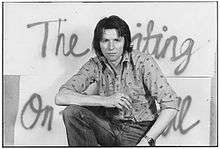Roger Perry (photographer)
| Roger Perry | |
|---|---|
 Roger Perry, 1976 | |
| Born | England, UK |
| Nationality | British |
| Education | Harrow Technical College and School of Art |
| Known for | Photography |
Roger Perry (1944 - 1991) was an English photographer, best known for his work at Time Out, as well as The Sunday Times and The Observer colour magazines. His 1976 book of London graffiti photography The Writing on The Wall (with an introduction by George Melly) was one of the first extensive surveys of the city's burgeoning 'scene'.[1]
Life and career as photographer
Perry studied at Harrow School of Art after deciding to become a professional photographer. Around this time he became friends with Tony Elliott who was studying at Keele University, editing a student magazine that Perry contributed to. When Elliott went on to found Time Out, he got Perry on board as house photographer. Working alongside designer Pearce Marchbank, Perry created hundreds of iconic covers for the London listings magazine.[2]
One cover that Perry photographed, working with Pearce Marchbank, came third in the Professional Publishers Association Cover of the Century award. It depicted Churchill's trademark V-Sign, with Marchbank's studio cleaner acting as 'hand-double' for the shoot.[3]
The 80's saw Perry moving into photojournalism, particularly for the colour supplements of the Sunday newspapers such as The Sunday Times, where he regularly worked on the 'Life in the Day' feature.
Due to severe rheumatoid arthritis, Perry retired to Suffolk where he began trading and restoring classic Lancia's. He was known to use his Lancia Stratos as an everyday runaround car.
He eventually died in Cambridge in 1991, with large obituaries published in many of the publications he used to contribute to, with Ian Jack writing an extensive one for The Independent.
In 2014 Perry's long out-of-print graffiti book "The Writing on The Wall" was republished after a Kickstarter campaign was started by George Stewart-Lockhart. The new edition is expanded to include never before seen photographs, with an extensive new foreword, as well as a short essay by Bill Drummond.[4] The original introduction by George Melly was also included, as well as numerous recollections about Roger from friends and colleagues such as Tony Elliott, Neil Lyndon and Simon Park, amongst others.
Writing in The Guardian on the subject of The Writing On The Wall, Alexis Petridis wrote that 'Perry’s photos offer a vivid snapshot of British culture in the mid-70s, between the final curdling of the hippy counterculture and the arrival of punk'.[5]
Publications
- Roger Perry, The Writing on The Wall, London: Elm Tree Books, 1976. ISBN 024189252X
- Roger Perry, The Writing on The Wall (Expanded Edition), London: Plain Crisp Books, 2015. ISBN 978-0993152009
Selected exhibitions
- "Photography in the Theatre", Impressions Gallery, York, 1973. With Angus McBean, Cecil Beaton and John Walmsley[6]
- "Graffiti", The Roundhouse, London, 1978.[7]
- "Punk: Photographs", Impressions Gallery, York, 1978.[8]
References
- ↑ "Political discourse woz ere: Book of London's graffiti in the 1970s harks back to a time when spray-painting wasn't just about mindless 'tagging'". Mail Online.
- ↑ "Roger Perry". Unfinished Histories.
- ↑ "Are these the best magazine covers of the century?". The Telegraph.
- ↑ Stewart-Lockhart, George. "LONDON'S ORIGINAL GRAFFITI ARTISTS WERE POETS, PLAYWRIGHTS AND POLITICAL REVOLUTIONARIES". Vice.
- ↑ Petridis, Alexis. "Spraying the 70s: the pioneers of British graffiti". The Guardian.
- ↑ British Journal of Photography. 129: 223. 1982. Missing or empty
|title=(help) - ↑ The Artist. 93: 253. 1978. Missing or empty
|title=(help) - ↑ Creative Camera. Issues 169-174: 283. Missing or empty
|title=(help)